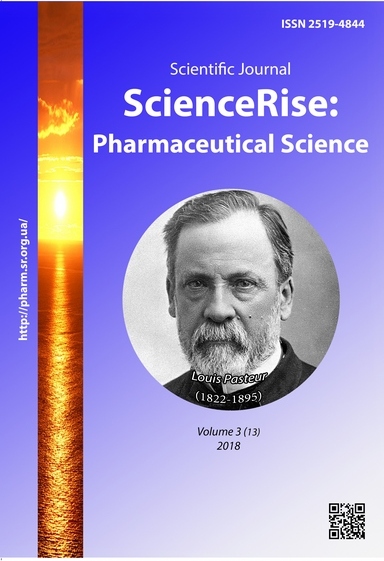Identification and component analysis of triterpenoids in Monarda fistulosa L. and Ocimum americanum L. (Lamiaceae) aerial parts
DOI:
https://doi.org/10.15587/2519-4852.2018.135767Keywords:
Lamiaceae, Monarda fistulosa, Ocimum americanum, HPLC, triterpenoids, aerial part, ethanolic extractAbstract
Despite the progress in the creation of synthetic drugs, herbal medicines do not lose their relevance nowadays. Triterpenoids are quite common in the plant world and exhibit a wide range of biological activity. Medicinal plants of the Lamiaceae family can accumulate mainly pentacyclic triterpenoids which demonstrate the anti-inflammatory, antioxidant, hepatoprotective, anticancer and antimicrobial properties. Nowadays a number of new, poorly-studied species of the family have been introduced in Ukraine, including Monarda fistulosa L. and Ocimum americanum L.
The aim of this study was to identify the triterpenoids and to analyze the contents of their components in ethanolic extracts of M. fistulosa and O. americanum (Lamiaceae) aerial parts under the condition of their farming in West Podillya (Ukraine).
Methods: foam test, sedimentation and color reaction were used to determine the presence of triterpenoids in plant material; high-performance liquid chromatography (HPLC) method was used to determine their components' content; determination was carried out on a liquid chromatograph Shimadzu LC 20 Prominence.
Results. The presence of triterpenoids in M. fistulosa and O. americanum ethanolic extracts was proved by the reactions of identification and HPLC. Effective extraction of triterpene compounds from the investigated plants was achieved using 96 % and 70 % ethanol. The comparative HPLC-analysis showed significant differences in content of ursolic, euscaphic, tormentic and oleanolic acids, betulin and lupeol in the aerial parts of investigated species. The most abundant components of M. fistulosa and O. americanum herbs were the ursolic and euscaphic acids.
Conclusions: It was identified the presence and evaluated the contents of 6 triterpenoids in M. fistulosa and O. americanum aerial parts. The obtained data can be used in the planning of pharmacological studies and in the chemotaxonomy of Lamiaceae familyReferences
- Lu, J.-J., Pan, W., Hu, Y.-J., Wang, Y.-T. (2012). Multi-Target Drugs: The Trend of Drug Research and Development. PLoS ONE, 7 (6), e40262. doi: http://doi.org/10.1371/journal.pone.0040262
- Zolotaikina, M. Yu., Hontova, T. M., Kotov, A. H., Kotova, E. E., Hubar, S. M. (2016). Development of methods for identification of phenolic compounds in tansy flowers. ScienceRise, 4 (4 (21)), 38–41. doi: http://doi.org/10.15587/2313-8416.2016.67614
- Likarski roslyny: Entsyklopedychnyi dovidnyk (1992). Kyiv: Vyd-vo "Ukrainska entsyklopediia" im. M. P. Bazhana, 544.
- Derzhavnyi reiestr likarskykh zasobiv Ukrainy. Available at: http://www.drlz.com.ua
- Rakhmetov, D. B., Korableva, O. A., Stadnichuk, N. A. et. al. (2003). Katalog zavershennykh nauchnykh razrabotok otdela novykh kul'tur Natsional'nogo botanicheskogo sada im. M. M. Grishko. Kyiv: Nora-Druk, 76.
- Liu, J. (1995). Pharmacology of oleanolic acid and ursolic acid. Journal of Ethnopharmacology, 49 (2), 57–68. doi: http://doi.org/10.1016/0378-8741(95)90032-2
- Silva, M. G., Vieira, I., Mendes, F., Albuquerque, I., Dos Santos, R., Silva, F., Morais, S. (2008). Variation of Ursolic Acid Content in Eight Ocimum Species from Northeastern Brazil. Molecules, 13 (10), 2482–2487. doi: http://doi.org/10.3390/molecules13102482
- Sultana, N. (2011). Clinically useful anticancer, antitumor, and antiwrinkle agent, ursolic acid and related derivatives as medicinally important natural product. Journal of Enzyme Inhibition and Medicinal Chemistry, 26 (5), 616–642. doi: http://doi.org/10.3109/14756366.2010.546793
- Tsurkan, O. O., Holembiovska, O. I., Koliadych, O. P. (2013). Sukhovershky zvychaini Prunella vulgaris L. – tsinna likarska roslyna (Ohliad literatury). Fitoterapiia, 1, 51–55.
- Shanaida, M. I., Pokryshko, O. V. (2015). Antymikrobna aktyvnist efirnykh olii kultyvovanykh predstavnykiv rodyny Lamiaceae Juss. Annals of Mechnikov Institute, 4, 66–69.
- Shanaida, M., Kernychna, I., Shanaida, Yu. (2017). Chromatographic analysis of organic acids, amino acids, and sugars in Ocimum americanum L. Acta Poloniae Pharmaceutica. Drug Research, 74 (2), 729–732.
- Kovalev, V. N., Popova, N. V., Kislichenko, V. S. et. al. (2003). Praktikum po farmakognozii. Kharkiv: Izd-vo NFaU, 512.
- Chen, J. H., Xia, Z. H., Tan, R. X. (2003). High-performance liquid chromatographic analysis of bioactive triterpenes in Perilla frutescens. Journal of Pharmaceutical and Biomedical Analysis, 32 (6), 1175–1179. doi: http://doi.org/10.1016/s0731-7085(03)00160-2
- Lee, M. K., Ahn, Y. M., Lee, K. R., Jung, J. H., Jung, O.-S., Hong, J. (2009). Development of a validated liquid chromatographic method for the quality control of Prunellae Spica: Determination of triterpenic acids. Analytica Chimica Acta, 633 (2), 271–277. doi: http://doi.org/10.1016/j.aca.2008.12.038
- Pai, S. R., Joshi, R. K. (2016). Variations in Pentacyclic Triterpenoids in Different Parts of Four Ocimum Species Using Reverse Phase-High Performance Liquid Chromatography // Proceedings of the National Academy of Sciences, India Section B: Biological Sciences, 87 (4), 1153–1158. doi: http://doi.org/10.1007/s40011-015-0682-y
- Tartynska, H. S., Zhuravel, I. O., Kyslychenko, V. S. (2017). Identyfikatsiia ta vyznachennia kilkisnoho vmistu tryterpenovykh ta steroidnykh spoluk talabanu polovoho (Thlaspi arvense L.). Int. research and practice conf. Lublin, 139–142.
- Razborsek, M. I., Voncina, D. B., Dolecek, V., Voncina, E. (2008). Determination of Oleanolic, Betulinic and Ursolic Acid in Lamiaceae and Mass Spectral Fragmentation of Their Trimethylsilylated Derivatives. Chromatographia, 67 (5-6), 433–440. doi: http://doi.org/10.1365/s10337-008-0533-6
- Marzouk, A. M. (2009). Hepatoprotective Triterpenes from Hairy Root Cultures of Ocimum basilicum L. Zeitschrift Für Naturforschung C, 64 (3-4), 201–209. doi: http://doi.org/10.1515/znc-2009-3-409
Downloads
Published
How to Cite
Issue
Section
License
Copyright (c) 2018 Mariia Shanaida, Olena Golembiovska

This work is licensed under a Creative Commons Attribution 4.0 International License.
Our journal abides by the Creative Commons CC BY copyright rights and permissions for open access journals.








